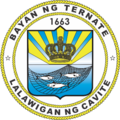Ternate Bahra | |
|---|---|
| Municipality of Ternate | |
Santo Niño de Ternate Parish Church Ternate Marker along Governor's Drive Ternate Town Plaza | |
| Nickname: Hispanic Centre of Luzon | |
 Map of Cavite with Ternate highlighted | |
Location within the Philippines | |
| Coordinates: 14°17′N120°43′E / 14.28°N 120.72°E | |
| Country | Philippines |
| Region | Calabarzon |
| Province | Cavite |
| District | 8th district |
| Founded | 1857 |
| Annexation to Naic | October 15, 1903 |
| Chartered | January 1, 1916 |
| Named after | Ternate, Indonesia |
| Barangays | 10 (see Barangays) |
| Government | |
| • Type | Sangguniang Bayan |
| • Mayor | Lamberto D. Bambao |
| • Vice Mayor | Salvador C. Gubio Jr. |
| • Representative | Aniela Bianca D. Tolentino |
| • Municipal Council | Members |
| • Electorate | 17,919 voters (2025) |
| Area | |
• Total | 59.93 km2 (23.14 sq mi) |
| Elevation | 53 m (174 ft) |
| Highest elevation | 649 m (2,129 ft) |
| Lowest elevation | 0 m (0 ft) |
| Population (2024 census) [3] | |
• Total | 24,891 |
| • Density | 415.3/km2 (1,076/sq mi) |
| • Households | 6,344 |
| Demonym | Ternateño |
| Economy | |
| • Income class | 4th municipal income class |
| • Poverty incidence | 5.56 |
| • Revenue | ₱ 313.1 million (2022) |
| • Assets | ₱ 401.2 million (2022) |
| • Expenditure | ₱ 136.4 million (2022) |
| • Liabilities | ₱ 21.12 million (2022) |
| Service provider | |
| • Electricity | Manila Electric Company (Meralco) |
| Time zone | UTC+8 (PST) |
| ZIP code | 4111 |
| PSGC | |
| IDD : area code | +63 (0)46 |
| Native languages | Chavacano Tagalog |
| Website | www |
Ternate, officially the Municipality of Ternate (Filipino : Bayan ng Ternate; Chavacano : Municipalidad de Ternate), is a municipality in the province of Cavite, Philippines. According to the 2024 census, it has a population of 24,891 people. [5]
Contents
- Etymology
- History
- Geography
- Barangays
- Climate
- Demographics
- Language
- Religion
- Economy
- Government
- Elected officials
- Education
- Primary and elementary schools
- Secondary schools
- Higher educational institution
- References
- External links
Formerly known as Bahra, the municipality is named after Ternate island of Indonesia where migrants from then Dutch East Indies originated.





